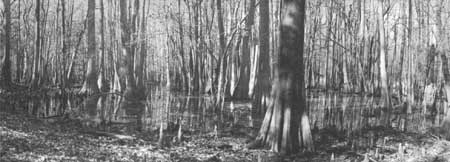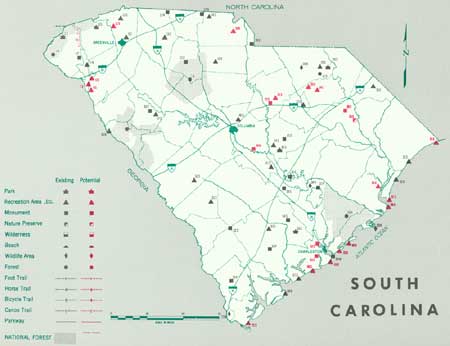.gif)
Parks for America
MENU
|
Parks for America
|

|

|
| As a scientific area, South Carolina's Congaree Swamp merits national monument status. |
SOUTH CAROLINA
SOUTH CAROLINA'S mountains, seashore, extensive forests, rivers, and reservoirs, combined with mild winters and warm summers, enable residents and visitors to enjoy outdoor recreation throughout the year.
The population increased 12 percent in the 1950-60 decade to 2,382,594, with a 26-percent increase occurring in urban areas and a 4-percent increase in rural sections. With only 41 percent of the population urban, the average density was 79 persons per square mile.
The tourist industry ranked fifth in the State's economy in 1960 and had an estimated value of $200 million.
An extensive and well-developed highway system—to be supplemented by four interstate routes—permits easy access to the existing recreation areas and scenic attractions.
Recreation resources are rather well located in relation to population, though urban spread is evident and much remains to be done to preserve available lands near the metropolitan centers. Increasing private development along the ocean shore is rapidly reducing public ownership possibilities.
Fishing and hunting resources afford year-round recreation and are being improved upon. The Atlantic shore and the mountains will continue to afford the best resources for fulfilling future recreation needs. A memorable colonial history along with a Civil War background gives the State a rich historical heritage. Eight sites not in the National Park System possess exceptional value in commemorating the history of the United States.
EXISTING PUBLIC AREAS
NATIONAL: The National Park Service administers one national battlefield site, one national military park, and one national monument totaling 3,953 acres. The 1960 attendance was 303,500. The Forest Service administers two national forests totaling 587,260 acres, in which 111 acres are devoted to four recreation areas. The attendance for 1960 was 530,890. The Bureau of Sport Fisheries and Wildlife manages four national wildlife refuges totaling 160,826 acres. Two reservoirs (1 under construction) managed by the Corps of Engineers have 92,000 water-acres with 213 access points. The 1960 attendance was 2,907,800.
STATE: The Division of State Parks administers 31 parks and historical areas totaling 42,811 acres; 1960 visitation was 3,324,276. The Division of Forestry has four forests totaling 123,494 acres. (One major forest of 92,000 acres is tabulated.) The 1960 attendance was 5,000. The Department of Wildlife Resources manages 2 refuges totaling 6,650 acres and 19 game management areas totaling 631,187 acres under lease or cooperative agreement.
The State Highway Department administers 105 roadside parks.
LOCAL: South Carolina city parks are all located within city boundaries.
PRIVATE ENTERPRISE: A significant role is played by private enterprise in developing resorts along the seashore. Several privately developed gardens are widely known and are important in the recreation picture of the State. Power company reservoir impoundments offer additional recreation opportunities.
LOCAL: Establishment of one recreation area.
PARK AND RELATED NEEDS
Prompt action is needed to protect the remaining seashore and mountain areas for public enjoyment. The fast-growing urban population accentuates the urgency to conserve and develop remaining resources in the metropolitan areas of Charleston and Columbia. A good partial solution to local and State recreation needs is to provide for improved developments on reservoirs. In addition to park and related areas as such, much can be done to foster a desire to retain streams in their natural state and to provide adequate waysides to serve the public needs. Existing State recreation areas provide only 42,811 acres for more than 2 million residents. No local nonurban areas have been identified. There is an immediate need for development of more State parks and local recreation areas. Potential areas identified in this plan total 41,924 acres judged of State significance and 1,000 acres of local importance. Other areas should be provided to meet the anticipated demand by 1976.
RECOMMENDATIONS
Existing recreation resources and many potential areas are shown on the accompanying tabulation and map. The following program to help provide needed additional outdoor recreation opportunities is strongly recommended.
NATIONAL: Establishment of the Congaree Swamp as a national monument.
STATE: Expansion of the State park system by addition of three recreation areas and one historic monument. Further study of 18 suggested areas. Designation and protection for one canoe trail.
Supporting recommendations include—
1. Initiation of cooperative studies to determine the feasibility of acquiring offshore islands for development as State recreation areas.
2. Improvement of existing waysides and initiation of studies to provide additional waysides.
3. Cooperative planning with private power interests to provide adequate recreation facilities on reservoirs.
(Table omitted from online edition)

|
| (click on image for an enlargement in a new window) |
NEXT >>>
|
|
Last Modified: Mon, Sep 6 2004 10:00:00 pm PDT
parks_america/south_carolina.htm
 Top
Top